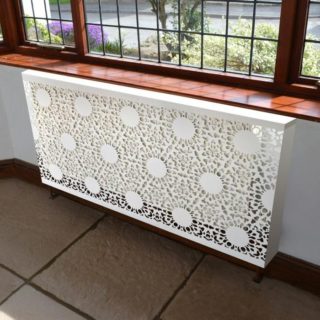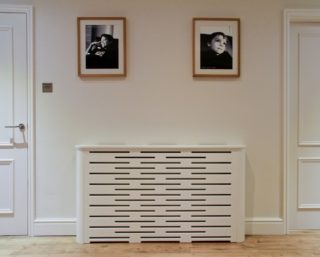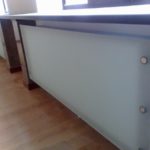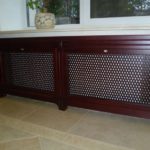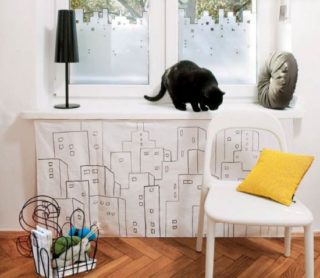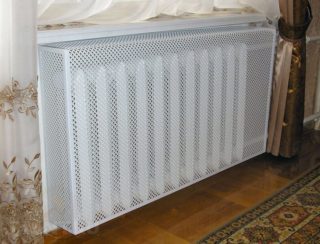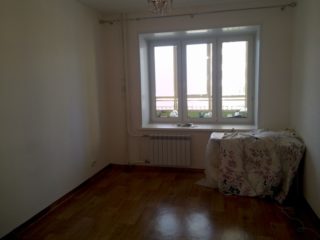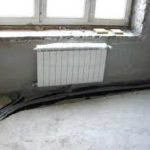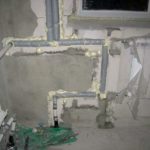In the Russian climate, home heating is indispensable. But the radiators under the window openings do not always look aesthetically pleasing, violating the beauty of the interior. In addition, at a high heating temperature, the surface of the heater can be burned. But if you know how to close the battery in a room beautifully, you can add a twist to the design of the room and protect yourself from the dangers of excessive heat.
Using special screens
To close the heating radiators in the house or apartment, you can use decorative screens. Choose the one that suits you in two ways - design and material.
Design Features
Masking shields are classified by the method of fastening to batteries. By this principle, box screens and hanging products are distinguished.
The decorative box consists of a frame with a coarse-mesh grate on the front side. Such products are used when you need to hide the unaesthetic appearance of the battery, and sometimes the pipes of the heating circuit. Boxes are installed throughout the window sill or only the radiator is closed. They can be equipped with opening doors, due to which it is easier to clean and regulate the temperature of the coolant.
There are two types of grid-mounted screens:
- models in the form of a horizontal panel located on top with a decorative grill mounted in it;
- options consisting only of the front part, which are called shields.
The first option is used to hide radiators located in niches or not closed on top of the windowsill, and installed directly on the battery.
Wall-mounted flat screens are often placed on radiators under a window that are not covered by a window sill. They are also used to hide batteries installed in niches.
Production material
To choose a decorative element for this indicator, you need to take into account the characteristic features of the material.
To mask the batteries used screens of the following materials:
- metal;
- wood;
- MDF;
- glass;
- plastic.
- Glass
- Metal
- Wood
- MDF board
To close ugly radiators, most often apartment owners prefer simple boxes made of white metal. Such options can not be called sophisticated, but they are inexpensive and give heat well. If strength and appearance are important, and the cost does not matter, it is better to opt for a stainless steel product that has a long service life and aesthetic design. Typically, such decors are used to hide cast iron radiators.
Masking panels made of natural wood are beautiful and environmentally friendly. When choosing wooden elements for radiators, it should be borne in mind that inexpensive screens are deformed when humidity and temperature changes. Therefore, it is wiser to invest in a product from noble varieties of wood.
MDF is the most practical and inexpensive material that has all the advantages of wood and at the same time is not afraid of moisture, temperature changes. Screens from this material are less prone to deformation and curvature. On sale there are openwork options from MDF.
Glass panels for radiators stand out for their maximum design variability. They are made entirely of glass or with the addition of other decorative materials. The location of the corners must be such that it was impossible to get hurt or catch on clothes. Typically, drawings and patterns are applied to the surface of the product.To prevent the glass from breaking or scratches on it, it is covered with a laminate. In addition to laminated glass, triplex or acrylic is often used.
Plastic screens are the cheapest, but at the same time dangerous option. The shield undergoes deformation from the heat of a hot radiator and releases harmful components into the air. Such screens are undesirable to use where people are for a long time.
Decorate protective screens by photo printing, decoupage. They are painted by hand, decorated with carvings, a self-adhesive lead film that does not deteriorate when heated.
Hand-made battery decoration
If you don’t want to spend money, there are ways to simply hide the battery in the room, creating a do-it-yourself cover. The maximum budget option is to hide the batteries in the interior - paint them in the color of the walls. You can paint the radiator manually by making a design element from a boring device.
You can beat the heating device using textiles. In this case, ordinary curtains are used or a piece of a suitable, not too dense fabric stretched over a specially made frame. If the batteries are too hot, the fabric should be made of natural fibers - synthetics can melt.
Decorative panels of removable or attached type are one of the most convenient options for hiding radiators. The decor is created from plastic, drywall, MDF panels. Such a screen can be designed as a shelf. But you should take into account the significant disadvantages of these materials. Because of them, heat transfer in the room is very difficult. Safety in terms of ecology is a big question, since chemical additives are used for the manufacture, which, when heated, begin to stand out, which can be harmful to health.
Battery - that part of the heating system, which at any time may require free access, for example, to perform urgent repairs. For this reason, it is not allowed to cover the radiators with deaf boxes and other structures that cannot be quickly removed if necessary.
Requirements for decorative elements
Before hiding the battery, it should be noted that there should be no obstacles to the circulation of heated air from above, below and from the side. Therefore, boxes and panel screens are usually equipped with grilles.
Equally important is the distance from the floor to the edge of the decorative element. It should be at least 8 cm. Through this gap, cold air rises along the radiator section, heating up along the way. If the gap is closed, heat transfer is disrupted.
It is worth taking into account the formation of dust on screens and boxes during convection. For this reason, you need to select the product from a material that is easy to wet cleaning.
Decorative overlap must be resistant to long-term exposure to high temperatures.
In addition to decorativeness, screens play a protective role, because they hide the edges of heating appliances, reducing the risk of various injuries. But if the box itself with notches or sharp corners, it will pose a risk of injury. Joints should be covered with a rounded border.
How to hide a pipe
Sometimes it is required to hide not only the radiator itself, but also the pipe segments brought to it. For this, different methods are used:
- Open way. The fastest. The pipes are painted in the color of the walls, which makes them almost invisible. The idea of decorating with improvised material, for example, painting a heating element in the color of a tree and fixing twigs on it, may also become interesting and original.
- Hidden broach. Pipes are hidden in the strobes in the wall and are covered with lining. The downside is that the skin in case of a breakthrough will have to be opened, so this method is absolutely not suitable for the old wiring.
- Screed packaging. A similar method of laying the line is suitable if the concrete layer has not yet been poured. It also requires a labor-intensive opening in the event of an accident, so you should keep the communication lines plan in case the heating system is repaired.
- Closure with a wide baseboard. This is possible if the heating pipes run along the floor. If there is a similar arrangement of the heating circuit in the bathroom or in the kitchen, you can make a design similar to a stair step and decorate it with tiles.
- In screed
- In the baseboard
- False wall
- In the gate
A good option is to use false walls. Behind a decorative partition you can hide anything, including heating elements. But the false wall must be quickly disassembled so that you can provide free access in the event of an accident. The easiest way is to create a frame bulkhead from a bar or a metal profile and sew it with drywall, plastic or plywood. It is useful to expose hatches with flaps at the places where the pipes are connected to the heating device and where the couplings and tees are located. It is good if the area of the room allows you to install a decorative coating not close to the battery so that it does not heat up too much and does not emit potentially dangerous substances.
Knowing how to decorate pipes or radiators in an apartment or in a private house, one can easily solve the problem of masking the engineering interchange. Decorative overlap will improve the appearance without compromising the efficiency of space heating. Also, a beautiful screen will allow you to get rid of long, dust-collecting curtains in favor of modern rolled or Roman paintings.
